| Author |
Message |
Sean Flynt

|
 Posted: Tue 27 Feb, 2007 8:17 am Post subject: Need sword I.D./Aesthetic opinion Posted: Tue 27 Feb, 2007 8:17 am Post subject: Need sword I.D./Aesthetic opinion |
 |
|
This sword features a broad, 31" blade with pronounced taper and single, narrow central fuller. The hilt features vertically recurved quillons, two side rings and an apple-shaped pommel.
What period and region would you say this sword represents?
What do you think of the overall loook of this weapon?
Do you like the proportions?
What would you change?
I have my own answers to these questions, but I'm eager to know what others think. Some of you will quickly figure out the origin of this modern repro--please keep that secret until I've collected a few opinions, but don't hesitate to chime in with your answers to the questions. 
Thanks for your feedback!
-Sean
 Attachment: 35.28 KB Attachment: 35.28 KB

-Sean
Author of the Little Hammer novel
https://www.amazon.com/Little-Hammer-Sean-Flynt/dp/B08XN7HZ82/ref=sr_1_1?dchild=1&keywords=little+hammer+book&qid=1627482034&sr=8-1
|
|
   |
 |
Roger Hooper

|
 Posted: Tue 27 Feb, 2007 8:38 am Post subject: Posted: Tue 27 Feb, 2007 8:38 am Post subject: |
 |
|
I remember the repro -
Scottish, 17th century.
Overall, looks very good. The only thing I might change is to make the grip 0.5 to 1 inch longer
Maybe make the pommel just slightly larger.
|
|
  |
 |
Bill Grandy
myArmoury Team


|
 Posted: Tue 27 Feb, 2007 8:49 am Post subject: Posted: Tue 27 Feb, 2007 8:49 am Post subject: |
 |
|
While I know what the original company called it, I would say it looks German to my eyes. I would also say it feels more like a 16th century sword, but 17th century is not out of the question.
I don't think it looks bad at all. The fuller looks a little odd... it seems to be squared as it gets towards the tip. I would round that out to look more natural. The profile of the blade looks a little weird... the transition to the point looks too machine-made somehow. If the profile were rounded more as it got there, it would look more natural (i.e. slightly more spatulate).
The grip looks like it should be re-wrapped with something less shiny.
HistoricalHandcrafts.com
-Inspired by History, Crafted by Hand
"For practice is better than artfulness. Your exercise can do well without artfulness, but artfulness is not much good without the exercise.” -anonymous 15th century fencing master, MS 3227a
Last edited by Bill Grandy on Tue 27 Feb, 2007 8:52 am; edited 1 time in total
|
|
   |
 |
|
Martin Wilkinson
|
 Posted: Tue 27 Feb, 2007 8:51 am Post subject: Posted: Tue 27 Feb, 2007 8:51 am Post subject: |
 |
|
I'd have said Italian 17th Century.
It looks like a military style cut and thrust.
I like the piece, i wouldn't change it.
"A bullet you see may go anywhere, but steel's, almost bound to go somewhere."
Schola Gladiatoria
|
|
   |
 |
Michael Edelson

|
|
   |
 |
Bill Love

|
 Posted: Tue 27 Feb, 2007 9:17 am Post subject: Posted: Tue 27 Feb, 2007 9:17 am Post subject: |
 |
|
I would add a scent stopper pommel like the one on the Windlass Towton. You could then subtract weight from the narrow end if you wanted to tweak the balance and still have a grip extension of sorts for your off hand to play with 
"History is a set of lies agreed upon."
Napoleon Bonaparte
|
|
  |
 |
Sean Flynt

|
 Posted: Tue 27 Feb, 2007 10:09 am Post subject: Posted: Tue 27 Feb, 2007 10:09 am Post subject: |
 |
|
I can't stand the suspense!
Those of you who spotted the Windlass Steelcrafts Scottish Backsword hilt are correct.
Those of you who spotted the Angus Trim blade also are correct.
It's a Photoshop Frankensword. I actually have these components sitting on my workbench at the moment. I put them together digitally just to see how they'd look as a complete weapon before I launch into the actual handwork.
In this image, I've shortened the grip by about 1" to account for drilling through the pommel and peening the tang over a button.
My first thought when I held the hilt up to the bare AT was, "Italian military sword, ca. 1500." I'd probably broaden that to 1500-1600, but there's just something about the way all the components and proportions come together here that makes me think the earlier date works better. The broad, tapering, fullered blade seems vaguely cinqueda-ish, and the hilt details also remind me of some Italian hilts of the late 15th c.
I, too, would prefer a slightly larger pommel just for aesthetic reasons. I don't think that would necessarily improve handling in this case. It's a heavy pommel and a light, tapered blade. Plus, there's a good bit of steel in the cross, given the two side rings. It should feel pretty good. If I go through with the project, I'll also be adding a steel pommel button.
The grip is my main uncertainty. I'm trying to decide between the following options:
-simple, double-tapered grip with cord, leather wrap and single riser (similar to that shown above, but in oxblood)
-double-tapered, faceted grip with leather wrap and single riser (the shape of the antique's grip, below, but covered in cord and oxblood leather)
As of right now, I'm leaning toward the faceted grip, but I'd like to hear your opinions and suggestions.
Do you think this looks historically plausible enough for me to proceed?
 Attachment: 46.27 KB Attachment: 46.27 KB
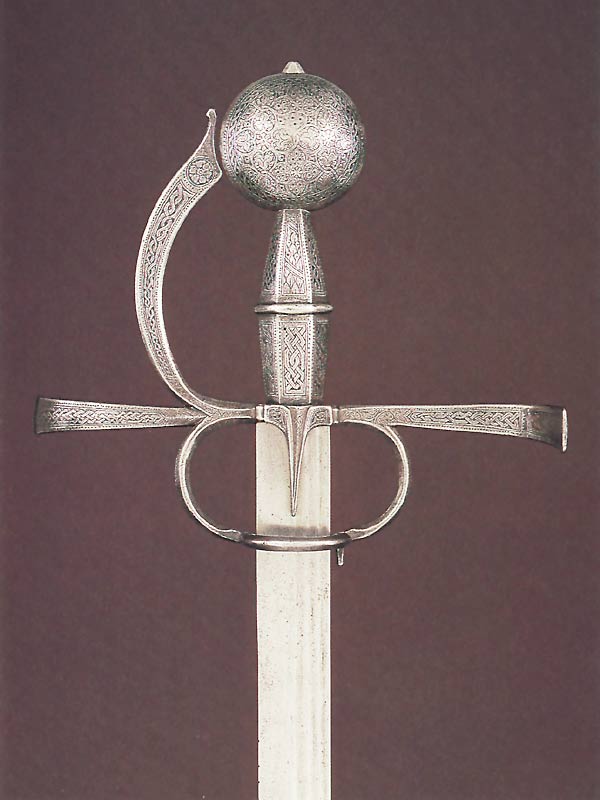
-Sean
Author of the Little Hammer novel
https://www.amazon.com/Little-Hammer-Sean-Flynt/dp/B08XN7HZ82/ref=sr_1_1?dchild=1&keywords=little+hammer+book&qid=1627482034&sr=8-1
Last edited by Sean Flynt on Tue 27 Feb, 2007 10:14 am; edited 2 times in total
|
|
   |
 |
Daniel Staberg

|
 Posted: Tue 27 Feb, 2007 10:10 am Post subject: Posted: Tue 27 Feb, 2007 10:10 am Post subject: |
 |
|
|
From the side it looks very much like a Dutch-Swedish sword from the first half of the 17th Century but those only hade one side ring not two.
|
|
  |
 |
Sean Flynt

|
 Posted: Tue 27 Feb, 2007 10:26 am Post subject: Posted: Tue 27 Feb, 2007 10:26 am Post subject: |
 |
|
| Daniel Staberg wrote: | | From the side it looks very much like a Dutch-Swedish sword from the first half of the 17th Century but those only hade one side ring not two. |
That's easily remedied  Do you know where I could find a photo of such a sword, Daniel? I think this piece could work as a ca. 1600 military sword, although most of those I've seen are of un-fullered diamond section (like A&A's Town Guard Sword). The grip treatment could be a key to creating something plausible for that era. What kind of grips did the Dutch-Swedish swords have? Twisted wire, I assume, but perhaps not.... Do you know where I could find a photo of such a sword, Daniel? I think this piece could work as a ca. 1600 military sword, although most of those I've seen are of un-fullered diamond section (like A&A's Town Guard Sword). The grip treatment could be a key to creating something plausible for that era. What kind of grips did the Dutch-Swedish swords have? Twisted wire, I assume, but perhaps not....
-Sean
Author of the Little Hammer novel
https://www.amazon.com/Little-Hammer-Sean-Flynt/dp/B08XN7HZ82/ref=sr_1_1?dchild=1&keywords=little+hammer+book&qid=1627482034&sr=8-1
|
|
   |
 |
Sean Flynt

|
|
   |
 |
Sean Flynt

|
|
   |
 |
|
Jonathan Hopkins
|
 Posted: Wed 28 Feb, 2007 1:51 pm Post subject: Posted: Wed 28 Feb, 2007 1:51 pm Post subject: |
 |
|
Sean,
I just came across these swords in Leslies Southwick's The Price Guide to Antique Edged Weapons, and thought I'd share as they seem to be at least relatives of the MRL Scottish backsword. Some of the side rings have pierced plates, as can be seen in the attachments.
Jonathan
 Attachment: 50.67 KB Attachment: 50.67 KB
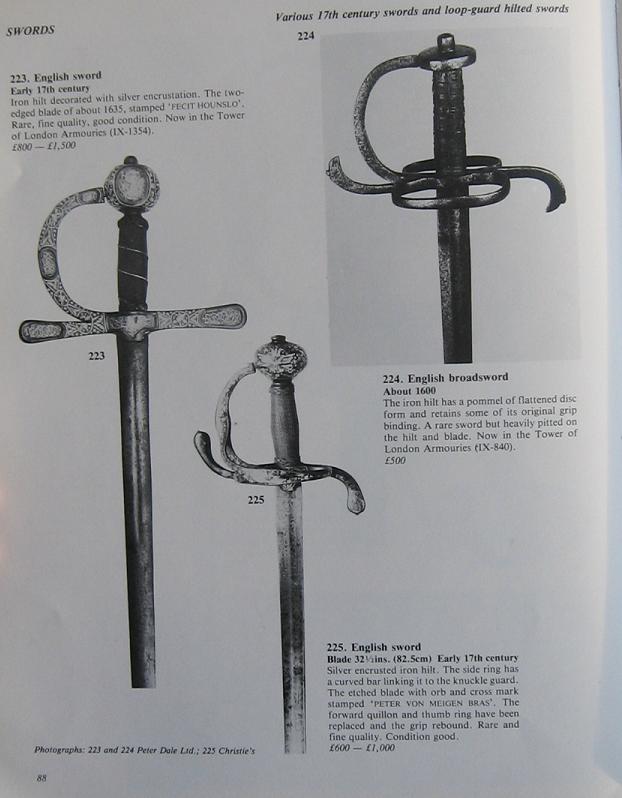
 Attachment: 57.64 KB Attachment: 57.64 KB
[ Download ]
|
|
  |
 |
Sean Flynt

|
 Posted: Wed 28 Feb, 2007 2:02 pm Post subject: Posted: Wed 28 Feb, 2007 2:02 pm Post subject: |
 |
|
Thanks, Johnathan! # 224 is especially interesting, with that disk pommel. I've seen that feature only on basket hilt swords and some daggers. The open side rings and quillons are certainly similar to MRL's Scottish Backsword. I think #229 is the sword MRL was actually trying to create with their Scottish Backsword. It's from an illustration in Scottish Armies of the English Civil Wars, and the text mentions infantry swords imported from northern Europe. They're beautiful swords, in my opinion. I think mine is going to be 50-75 years earlier, solidly in the 16th c.
-Sean
Author of the Little Hammer novel
https://www.amazon.com/Little-Hammer-Sean-Flynt/dp/B08XN7HZ82/ref=sr_1_1?dchild=1&keywords=little+hammer+book&qid=1627482034&sr=8-1
|
|
   |
 |
|
Korey J. Lavoie
Location: New Hampshire, USA Joined: 06 Apr 2006
Posts: 63
|
 Posted: Thu 01 Mar, 2007 8:28 am Post subject: Posted: Thu 01 Mar, 2007 8:28 am Post subject: |
 |
|
| Sean Flynt wrote: | | I'm starting to get fired up about removing the inboard side ring. The single ring seems to be much more common. |
I hope I'm not too late but In my opinion: That's all the more reason you shouldn't remove it and give Your Sword a unique feature that really sets it apart from a sword that was standard for that time period. It's always the Weapons with some odd quirk or other feature that stand out and get cited in books, photographed, mused over and remembered . That's just my take on the issue from my own standpoint; I'm sure it will be a great sword either way. So if it doesn't mesh with what you would look for in a Sword, just return to whatever feels right for you.
I like the overall design though, it looks like it will be one of those terrific cutters that just flows, both in it's design and movements.
From the hundred year war
To the Crimea
With a Lance and a Musket and a Roman Spear
To all of the Men who have stood with no fear
In the Service of the King
-The Clash: The Card Cheat
|
|
  |
 |
Sean Flynt

|
 Posted: Thu 01 Mar, 2007 8:58 am Post subject: Posted: Thu 01 Mar, 2007 8:58 am Post subject: |
 |
|
| Korey J. Lavoie wrote: | | Sean Flynt wrote: | | I'm starting to get fired up about removing the inboard side ring. The single ring seems to be much more common. |
I hope I'm not too late but In my opinion: That's all the more reason you shouldn't remove it and give Your Sword a unique feature that really sets it apart from a sword that was standard for that time period. It's always the Weapons with some odd quirk or other feature that stand out and get cited in books, photographed, mused over and remembered . That's just my take on the issue from my own standpoint; I'm sure it will be a great sword either way. So if it doesn't mesh with what you would look for in a Sword, just return to whatever feels right for you.
I like the design, it looks like it will be one of those terrific cutters that just flows, both in it's design and movements. |
Thanks, Korey! You raise a very interesting point that's hounded me since my first experiments in cutlery--the difference between historical accuracy and historical plausibility. Ultimately, this project will be about historical plausibility. A weapon of 1500-1550 could plausibly feature a blade like this one, a pommel like this one, a grip like this one and cross like this one (with one or two siderings). Historical accuracy isn't a goal because I know of no weapon with all these features. I simply can't find evidence that the design is implausible. That's why some of my original questions here are phrased to elicit negative feedback. I wanted folks to identify implausible elements--"That pommel doesn't appear on any swords before 1640" or "that blade and that cross are 200 years apart, stylistically".
I haven't made a final decision about the sidering. Once I have everything assembled, but not peened, I'll make the decision based more on handling and looks rather than on how many swords of this era had two siderings. I think both options are historically plausible.
A couple of years ago I argued for a category of reproductions between "historically accurate" and "fantasy," and suggested the term "speculative." As I wrote at the time, this category leaves room for imagination but requires research and concern for historical plausibility. The term died a quiet, lonely death, but I would ressurect it to describe my current project. 
-Sean
Author of the Little Hammer novel
https://www.amazon.com/Little-Hammer-Sean-Flynt/dp/B08XN7HZ82/ref=sr_1_1?dchild=1&keywords=little+hammer+book&qid=1627482034&sr=8-1
|
|
   |
 |
|
Korey J. Lavoie
Location: New Hampshire, USA Joined: 06 Apr 2006
Posts: 63
|
 Posted: Thu 01 Mar, 2007 9:58 am Post subject: Posted: Thu 01 Mar, 2007 9:58 am Post subject: |
 |
|
Your welcome Sean, I like your term too. It fits what I'd like to create in terms of blade design and geometry as well: Highly extrapolative designs that combine elements from different existing weapons, that present some very interesting features that would not detract from their effectiveness. For example, one design I drafted that I've fallen for combines the characteristics of both a Kukri and a Seax with extreme aspects of both (Picture a large, short blade with a full gaurd that has a straight, single-edged section for the first few inches: Abruptly sweeping forward drastically, increasing in width as well as thickening in cross-section before tapering and sweeping back to the point with a fully sharpened clip).
Finally, there was a sword that was posted on here recently that has characteristics very similar to yours: (I'll post it again). So you are definately on the right track in making a historically plausible design.
 Attachment: 29.75 KB Attachment: 29.75 KB
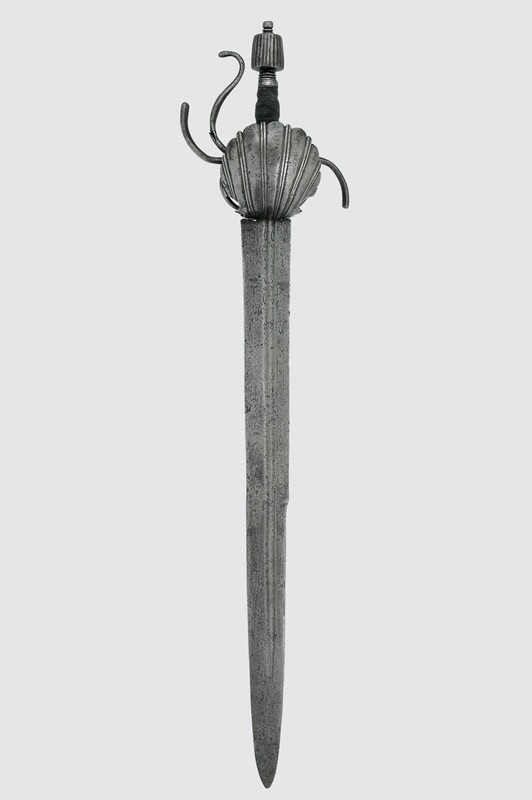
From the hundred year war
To the Crimea
With a Lance and a Musket and a Roman Spear
To all of the Men who have stood with no fear
In the Service of the King
-The Clash: The Card Cheat
|
|
  |
 |
|
Kjell Magnusson
|
 Posted: Thu 01 Mar, 2007 6:01 pm Post subject: Posted: Thu 01 Mar, 2007 6:01 pm Post subject: |
 |
|
| Sean Flynt wrote: |
Do you know where I could find a photo of such a sword, Daniel? |
Attaching a pic I took at the Army Museum in Stockholm, these should be a decent match I think. The one to the left is dated to the 1640s, and I think the right one is as well. No hilt closeups of these though, so instead I'm attaching another pic with a closeup of two hilts of roughly the same type and dating (left one dated 1620-30, right one first half of the 17th century). The two in the first pic, and the left one in the second, are all labeled as cavalry weapons, with the remaining one being without any such designation. (Should the order of the images be reversed, the on with the yellow background is the "first" one.)
Finally, the "frankensword" you posted did remind me of this cinqueda, though memory may have exaggerated the similarities a bit: http://www.veilingopbrengsten.nl/Webalbum/tho..._frame.htm
 Attachment: 61.57 KB Attachment: 61.57 KB
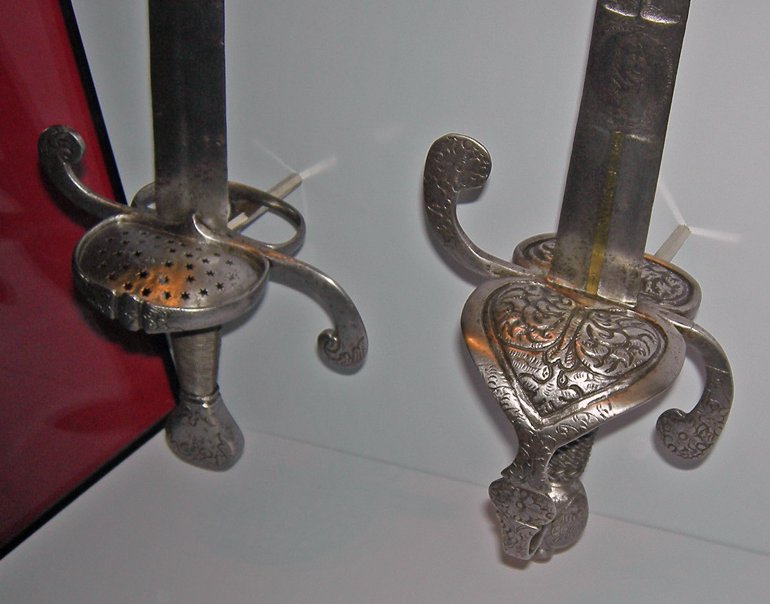
 Attachment: 56.89 KB Attachment: 56.89 KB
[ Download ]
|
|
  |
 |
Sean Flynt

|
 Posted: Fri 02 Mar, 2007 8:45 am Post subject: Posted: Fri 02 Mar, 2007 8:45 am Post subject: |
 |
|
Thanks for the great photos, Kjell! I don't think I can squeeze these later dates out of my sword. The flattened pommels and filled siderings of these later northern European swords are just so distinctive.... I sure would love to see somebody reproduce one of them, though. I've always admired the type. If my blade didn't have a fuller, I think I could more plausibly get closer to 1600, maybe create one of those short, narrow ricassos.
-Sean
Author of the Little Hammer novel
https://www.amazon.com/Little-Hammer-Sean-Flynt/dp/B08XN7HZ82/ref=sr_1_1?dchild=1&keywords=little+hammer+book&qid=1627482034&sr=8-1
|
|
   |
 |
Sean Flynt

|
 Posted: Tue 06 Jan, 2009 7:31 am Post subject: Posted: Tue 06 Jan, 2009 7:31 am Post subject: |
 |
|
I abandoned this project and made something slightly unsatsfying with the guard. Now I've reconsidered the original idea and gone so far as to rough-fit the cross to the blade. The pommel could be slightly larger for both looks and balance, but I'd like to make a Venetian-style grip with ferrules and what Oakeshott called "ballusters"-- filed steel vertical bars secured by the ferrules. With a simple poplar grip core, balance is ~5" below cross. The additional steel in the grip treatment and nut should bring that back a bit. So, let's project a BP of ~4.5" in the final product. Reasonable for a cut-and-thrust riding sword?I haven't fit the pommel yet so it's digitially moved down to where it would be in the final construction (there will be a pommel nut as well).
Looks like maybe first half of the 16th c. to me, and would look nice with a buckler.
Any thoughts about the looks now that it's taking shape in the real world?
 Attachment: 63.74 KB Attachment: 63.74 KB

 Attachment: 126.56 KB Attachment: 126.56 KB
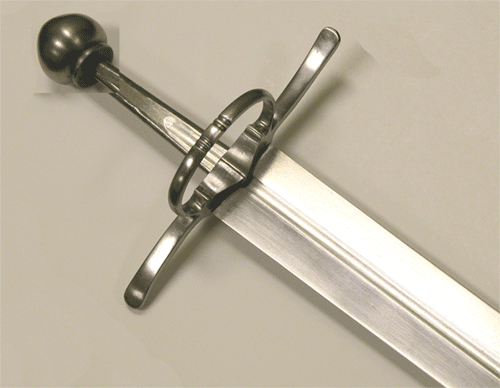
-Sean
Author of the Little Hammer novel
https://www.amazon.com/Little-Hammer-Sean-Flynt/dp/B08XN7HZ82/ref=sr_1_1?dchild=1&keywords=little+hammer+book&qid=1627482034&sr=8-1
|
|
   |
 |
Jean Thibodeau

|
 Posted: Tue 06 Jan, 2009 10:02 am Post subject: Posted: Tue 06 Jan, 2009 10:02 am Post subject: |
 |
|
I like this guard better as it looks more harmonious to me with a side ring than the one shown early in the Topic: The S shaped quillon just didn't look right to me with a ring guard ? ( Might be historically correct but just my preference ).
Oh, maybe not an issue but with this guard one could use the sword left handed and have the guard ring on the correct side of the hand, the S shape wouldn't work for the left hand when designed for right hand use.
Maybe a pommel like the one on the Albion Doge would work, assuming you could make one and fit it as the length of tang may not be enough unless the pommel is attached by another method than peening.
You can easily give up your freedom. You have to fight hard to get it back!
|
|
  |
 |
|
|
You cannot post new topics in this forum
You cannot reply to topics in this forum
You cannot edit your posts in this forum
You cannot delete your posts in this forum
You cannot vote in polls in this forum
You cannot attach files in this forum
You can download files in this forum
|
All contents © Copyright 2003-2025 myArmoury.com — All rights reserved
Discussion forums powered by phpBB © The phpBB Group
Switch to the Basic Low-bandwidth Version of the forum
|

